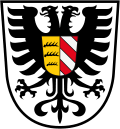Munderkingen

| Munderkingen | ||
|---|---|---|
| ||
 Munderkingen | ||
Location of Munderkingen within Alb-Donau-Kreis district 
 | ||
| Coordinates: 48°14′7″N 9°38′38″E / 48.23528°N 9.64389°ECoordinates: 48°14′7″N 9°38′38″E / 48.23528°N 9.64389°E | ||
| Country | Germany | |
| State | Baden-Württemberg | |
| Admin. region | Tübingen | |
| District | Alb-Donau-Kreis | |
| Government | ||
| • Mayor | Michael Lohner | |
| Area | ||
| • Total | 13.08 km2 (5.05 sq mi) | |
| Population (2015-12-31)[1] | ||
| • Total | 5,119 | |
| • Density | 390/km2 (1,000/sq mi) | |
| Time zone | CET/CEST (UTC+1/+2) | |
| Postal codes | 89597 | |
| Dialling codes | 07393 | |
| Vehicle registration | UL | |
| Website | www.munderkingen.de | |
Munderkingen is the smallest town in the district of Alb-Donau in Baden-Württemberg in Germany. It is situated on the Danube, 9 km southwest of Ehingen, and 31 km southwest of Ulm.
Buildings
Danube Bridge
The so-called "New Danube Bridge" 1893 was the first massive concrete arch bridge , which was built with an arch span of more than 50 m: Engineer Karl Leibbrand from Stuttgart was the builder, the work was carried out by the construction company Buck from Ehingen.[2][3] The bridge was in the war, on April 22, 1945, by retreating German engineering troops, busted. Reconstruction began immediately after the war. In June 1948, the re-created Danube bridge was inaugurated by the Occupying Power of the French zone.
Old hospital
Built in 1889-90, the historicist building belongs to the townscape.



References
- ↑ "Gemeinden in Deutschland nach Fläche, Bevölkerung und Postleitzahl am 30.09.2016". Statistisches Bundesamt (in German). 2016.
- ↑ s0006250 at Structurae
- ↑ Betonbrücken at Zeno.org. Article by: Viktor von Röll (ed.): Enzyklopädie des Eisenbahnwesens (Encyclopaedia of the Railway), 2nd edition, 1912–1923, Vol. 2, S. 271 ff. (Mit Darstellung des Längsschnittes und Gelenks der Donaubrücke)

